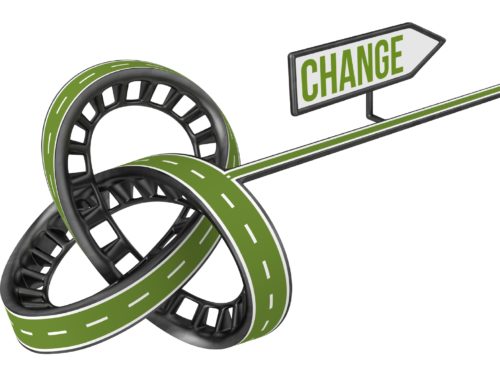“We think that society today suffers from a pervasive uncertainty about values, a relativism that undermines leadership and commitment alike.”
This could be an observation about life in any area of contemporary society. It isn’t. Terrence Deal and Allan Kennedy wrote it in their class book Corporate Cultures back in 1982.
In organizations, that uncertainty leads to dysfunctional cultures that undermine trust and create friction that erodes performance.
Deal and Kennedy also wrote about the importance of values to a company’s culture:
“Values are the bedrock of any corporate culture. As the essence of a company’s philosophy for achieving success, values provide a sense of common direction for all employees and guidelines for their day-to-day behavior.”
What Really Drives Your Culture?
Your organization’s culture is the culmination of its habits exhibited every day. Here’s how it happens: Choice — where you place your focus — influences action. Action over time becomes habit, and habits define your culture.
This pattern is true even if you choose not to make an intentional choice about your culture. A laissez-faire leadership approach or even abdicating your responsibility creates a tone that influences action that eventually becomes habit.
That makes choice the driving force that develops and sustains your culture.
“Wait a minute. Aren’t choices influenced by our values?”
Yes … in the ideal world. Unfortunately, that’s not the way it works much of the time.
A 2016 Gallup poll found that just 23 percent of employees strongly agree that they can apply their company’s corporate values to their everyday work and only 27 percent say that they strongly believe in them.
There are two additional factors that influence your choices: beliefs and aspirations.
How Beliefs Can Override Your Values
The executive team for a manufacturing company was crystal clear that honesty and respect were core values on which every action and communication should rest. Everyone believed them until Steve, the company’s leading sales person and not his real name, committed a termination-worthy offense with a customer.
The course of action should have been a “no-brainer” from a values perspective. It was complicated by their belief that terminating Steve’s employment could result in several customer defections. Business was good, but removing Steve would thwart their momentum.
Additionally, there were concerns that Steve might not accept a non-compete agreement in return for a severance. He was a known commodity in the industry, and a competitor might not have the same commitment to their core values.
The team unanimously agreed to give Steve a written disciplinary notice rather than terminate his employment. The decision visibly pained them. They were in a clear and, in their minds, unresolvable conflict between their core values and their beliefs about the business. Their beliefs won out, and that choice — not their core values — defined their culture.
The easy analysis of this situation is that honesty and respect were not really core values. Congratulations if you operate in a world that allows for exclusively binary decisions between what’s right and what’s not.
For many organizations, conflicts between values, beliefs, and aspirations occur on a regular basis. They are voiced in discussions over who is hired, fired, and promoted. They are evident in aspirational values that have not been part of the culture in the past. They are at the root of the age-old dilemma over the importance of quality over quantity; doing whatever it takes to complete the work or providing a family-friendly workplace; and being safe or being quick.
Choice is the ultimate driver of your culture. Factors beyond your stated core values are often part of the decision-making equation about where attention and focus are placed.
Create Alignment to Reduce the Conflicts
The idealist in me wants core values to be the exclusive bedrock of a great culture. The realist in me knows that beliefs and aspirations play an increasingly large role, too. The challenge is to combine the idealistic and realistic in a way that allows the organization to flourish in an uncertain future. Here are four ideas that help.
1. Translate values, beliefs, and aspirations into behavior and performance. Values are the things you consider important. Beliefs are those you consider to be true. Aspirations are the things you want to become to reach your desired state. That’s a lot for people to remember and translate into their daily work. It can be even more challenging when there is lack of agreement about what constitutes words such as accountability, respect, or even integrity.
One option to make alignment easier is to state your guiding beliefs, aspirations, and values as action-oriented behavior and performance.
Zappos is one of many organizations that have adopted this approach. It calls them “Core Values,” and they are articulated in 10 statements about how everyone should approach their work.
Ultimately, what you call your statements is much less important than how they are used to make choices every day. Hewlett-Packard was founded on the H-P Way. Johnson & Johnson has the J&J Credo. Ikea uses its Vision and Business Idea. The important thing is to translate the behavior and performance on which your culture is built in a way that makes it easier for people to see their importance and connection to success.
2. Be more thoughtful in your choices to consider the consequences.Remember that executive team from earlier in this piece? It should have slowed down its decision to consider the long-term and unintended consequences. The dishonest and disrespectful behavior continued to the point that it affected customer relationships. It also signaled that the leadership wasn’t really invested in the culture it said it wanted to build. That was a heavy price to pay, and it simply delayed the decision to terminate this person’s employment.
I wrote about “The Ethics Litmus Test” years ago in my book, On My Honor, I Will. It was adapted from the work of Harry Emerson Fosdick and Dr. Preston Bradley. These six questions are equally effective in making decisions that affect the entirety of your culture.
- Does your course of action seem logical, responsible, and legal?
- Would the results be beneficial if everyone made the same decision?
- How will your decision affect others? Where will it lead you?
- Will you think well of yourself when you think back on your decision?
- How would the person you most admire handle the situation?
- What would your friends and family think of your decision not IF but WHEN they discover it?
3. Be intentional about the connection between advancing the culture and success on the job. Mike Santoro, President of the tech public relations firm WalkerSands Communications, told me that positive choices to support the culture are used to determine what decisions are made and how the firm’s associates are evaluated.
This isn’t a new concept. James Cash Penney, founder of JCPenney, articulated seven principles to guide the company and its people in 1913. The “Penney Idea” became the foundation for how the company approached every aspect of its business — including how the success of its people was measured.
Santoro attributes his company’s 300 percent growth in the past 10 years to being intentional about its culture. It would be easy to conclude that JCPenney’s performance over the same time period reflects its commitment to the Penney Idea.
4. Pay more attention to the middle of the organization. A Fortune 100 executive asked me this question after a recent presentation: “How can I communicate what’s important about our culture to my division’s 20,000 employees around the globe?”
My response was, “You can’t. Your job is to get the total buy-in and commitment to the 10 people who report directly to you. Their job is to do the same with the 10 people for whom they are the direct supervisor. That continues until all 20,000 get it.”
If your organization has more than one level of leadership, getting alignment and commitment to every level between the top and bottom of your organizational chart is a must. Your front-line staff only occasionally sees the choices made by senior leaders. They experience the small choices made by their team leads, supervisors, and managers multiple times every day. Getting total alignment and commitment on the culture from the middle of the organization is one of the senior leader’s most important and difficult responsibilities.
This discussion about the importance of choice sounds familiar for a reason. Ralph Waldo Emerson popularized the concept back in 1875 when he wrote: “things said for conversation are chalk eggs. Don’t say things. What you are stands over you the while, and thunders so that I cannot hear what you say to the contrary.”
A common commitment to the guidelines for day-to-day behavior is absolutely required for a strong, vibrant culture. Call them values, beliefs, guiding principles, or whatever you want. The most important factor in their usefulness and relevance is conscious, courageous choice.
Randy Pennington is an award-winning author, keynote speaker, and leading authority on helping organizations achieve positive results in a world of accelerating change. To bring Randy to your organization or event, visit www.penningtongroup.com , email info@penningtongroup.com, or call 972.980.9857.
This article first appeared on the Medium platform: https://medium.com/aggressive-transformation/corporate-culture-consistent-courageous-choices-make-the-difference-ce264daa792e





